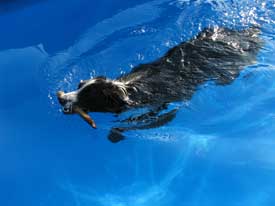
JUNE 11, 2014
Seven safety tips for active outdoor dogs
 With the long days of spring and summer ahead of us, now is the perfect time for your dog to enjoy the great outdoors. Taking some precautionary steps will help ensure you make the best of your dog’s outings. Here are 7 tips:
With the long days of spring and summer ahead of us, now is the perfect time for your dog to enjoy the great outdoors. Taking some precautionary steps will help ensure you make the best of your dog’s outings. Here are 7 tips:
Sun: Believe it or not, dogs can get sunburned. Dogs with short or predominantly white fur are especially at risk of becoming sunburned and can become at risk for solar dermatitis or even skin cancer. As a preventative, apply a sunscreen with SPF 15 or higher which doesn’t contain PABA to the tips of the ears, bridge of the nose, groin area, underbelly, and other places with thinner fur or exposed skin.
Heat: Just as you can protect your pets from sunburn, you can also keep them safe from heat stroke and other heat related problems by bringing them indoors or at least providing a shaded area in the yard. Also, offer plenty of clean water. The rule of thumb is one ounce of water daily for each pound of body weight. But this number increases when your dog is especially active or spends time in increased temperatures. Also, when walking, dogs often have so much fun they forget to take a break and can become overly hot and thirsty, so remember to carry a portable water bowl for summer outings and offer it your pet frequently.
Plants: Dogs are susceptible to plant-based irritants just as people are. When enjoying the great outdoors with your canine companion, be mindful of your surroundings, taking note of the different species of plants in the area. Discourage your dog from “grazing” along the trail’s edge, as many plants are toxic and can cause a wide range of problems from gastrointestinal disturbances to depression of the central nervous system.
Fleas & Ticks: Fleas and ticks are not only an uncomfortable nuisance, they can cause medical problems ranging from flea-allergy dermatitis to Lyme disease, ehrlichiosis, and Rocky Mountain spotted fever; all of which can be contracted by humans as well. For the comfort of all involved, talk to your vet about an appropriate flea and tick prevention program and be sure to examine your pet often, especially after hiking in wooded areas where ticks are common.
Critters: Dogs will be dogs and will do what dogs do! This often includes running gleefully after small, fast-moving critters such as squirrels, raccoons, gophers, skunks and other such critters. When off-leash, dogs can quickly find themselves out of range of worried owners, and many dogs have become lost or even hit by cars and killed this way. Keep in mind that many rodents and other small animals, while tiny, can put up a big fight with sharp teeth, claws and toxic stink-bombing technology (skunks!), so it’s best to prevent actual close-encounters whenever possible.
Nutrition: Just like active humans, active dogs will burn a lot of calories and energy when outdoors. Be sure to consult with your veterinarian to design the perfect diet for your active pet to match the requirements of their daily exercise routine.
Other Dogs & Unforeseen Situations: While you may not be able to avoid all the dangers, there are some basic commands that all dogs should know that will assist you with the prevention of potential problems. Make sure your dog has a good understanding of and is reliable with the commands “Leave it”, “Drop it”, “Come”, and “Stay”. These commands can be particularly useful in keeping your dog away from dead animals or feces, or avoiding a harsh interaction with another dog, human or another surprise animal.
All dogs can enjoy the outdoors, but stay safe by knowing the related risks and how to deal with them.
Learn more online at www.FetchPetCare.com.



